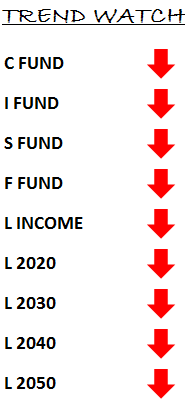
This is your TSP Watchdog UPDATE for the week ended November 23, 2018.
I hope everyone had a wonderful Thanksgiving!
Stocks did not. They posted a second week of big losses. The S&P 500 dropped 3.79% – which was the best of the three major indexes we track here. The Dow lost 4.44%, and the NASDAQ gave up 4.26%. The S&P 500 and the Dow are now both DOWN for the year; the NASDAQ is clinging to a small gain.
Thanksgiving week is often quiet – with a Christmas rally kicking off. Not so much this week! This was the worst Thanksgiving week since 2011.
Stocks are now down more than 10% from their September highs – signaling a correction.
As we have been discussing, investors are worried about global economic slowing, trade tensions and negative earnings surprises. Two new concerns moved front and center this week: tough earnings comparisons and collapsing oil prices.
Tough earnings comparisons are a product of rising profits – kind of a built in “governor” for the market. As the economy begins to grow, companies report increasing earnings. Initially, these earnings are compared to soft earnings from before the expansion, but as quarters pass, eventually, the comparisons are to strong periods. Last year at this time, Q3 earnings were being compared to Q3 2016 – before the earnings boom really kicked in. Gains from Q3 2016 to Q3 2017 were strong. This year, though, the comparison of Q3 earnings are to Q3 2017 – and that is a much higher bar to clear. Some companies are not showing as much growth, compared to Q3 2017, as analysts had been expecting. Earnings are growing – just not as much, on a percentage basis, as they were last year at this time because the baseline is much higher.
Oil prices have been struggling for several months, but they have really fallen off a cliff in recent weeks – losing 1/3 of its price in the last seven weeks (from its high of $75 to $50 this week). We’ve talked about the dual edge of oil prices in this space before: low prices are good for consumers but bad for oil companies. Since we’re talking about stock prices here, the impact of lower oil prices – especially when the decline is so sharp – is negative. Earnings will certainly be impacted, and energy is a big piece of the overall market.
The one positive in all the selling is that the Fed may step back from its aggressive plans for more interest rate hikes. Or maybe not. Analysts are unsure how the central bank will respond to recent market activity, and uncertainty is not a friend. The street will be watching the Dec 18-19 Fed meeting with bated breath. If the Fed does not raise rates in Dec, as has been expected for some time now, or if they provide dovish comments about future increases, the markets are likely to breath a sigh of relief (at least in the short tun). Conversely, if they go ahead and raise rates in Dec and/or provide hawkish commentary on future rate hikes, the market will continue its worries about rising rates – perhaps even escalating its fears.
In our TSP Watchdog database, we continue to have negative trends for all the primary funds (C fund, S fund, I fund and F fund). Fortunately, we’ve been in this posture for several weeks now – meaning we are out of the market as it slides. It is definitely a good time to be on the sidelines!
Going forward, if the market continues to struggle, we will be happy to stay out of harm’s way – in the G fund. On the other hand, if the market gets back on its feet, we will alert you if/when trends turn positive again.
Our primary objective is to avoid major downturns. Right now, we are positioned to do that if the market continues to slide.
If you missed our advice from a few weeks ago to get out of the market – and are still holding C fund, S fund, I fund and/or F fund (or any of the L funds) – you may be wondering what to do now. Should you just sell everything (at the risk of selling at the bottom of this correction)? Or is it too late to sell?
You might consider the same approach we recommend on the upside – when the question is reversed: is it too late to buy? To avoid the possibility of selling at the bottom, or at least to moderate the negative impact of bad timing, you might dollar cost average out of the market by selling part of your position now – and then continue selling on a pre-determined schedule as long as trends remain negative.
As an example, you might sell ¼ of your holdings now and then look to sell another ¼ every other week, as long as the trends remain negative. Because stocks often decline faster than they rise, it is reasonable to sell on a faster schedule than buying when trends are positive.
If this downtrend continues, it will be worth getting to the sidelines – kind of a “better late than never” thing. If we are already at, or close to, the bottom of this correction, dollar cost averaging your sales may minimize the negative impact of selling late.
When things get bumpy, we are here to answer your individual questions. Sometimes we get back-logged with questions when things get volatile – so please be patient if it takes a day, or so, to get back to you. But don’t shy away from asking…we’re here to help you get through these tough patches.
Scot B.
